#galaxy evolution explorer
Text

NASA Galaxy Evolution Explorer: Ultraviolet image of NGC 7293, also known as the Helix Nebula - the nearest example of what happens to a star as it evolves into a white dwarf (May 5, 2005)
#galaxy evolution explorer#astronomy#astrophotography#krakenmare#outer space#nasa#space#thank you nasa#nebula#ngc 7293#helix nebula#white dwarf#stars#2000s#2005
85 notes
·
View notes
Text
idan. with big spiky thick scaled tail
#dee s 9#you KNOW hes tearin his starfleet classmates apart in combat sim#they have to plastic wrap his tail spikes#hes so big and fast and designed specifically by evolution to obliterate#mans just wants to explore the galaxy and take silly photos for his family man. maybe help his yadek design a tail friendly clothing line
10 notes
·
View notes
Text

Celestial Symphony: Cosmic Tapestry of Planets and Stars!
#celestial#symphony#cosmic#tapestry#planets#stars#astronomy#universe#exploration#harmony#nebulae#galaxies#orbits#interstellar#constellations#astral#stellar evolution#astrology#galactic#solar systems#interplanetary#heavenly#astronomer's delight#starlight#cosmic dance#astral melodies#celestial wonders#star clusters#nebulous#astral plane
2 notes
·
View notes
Text
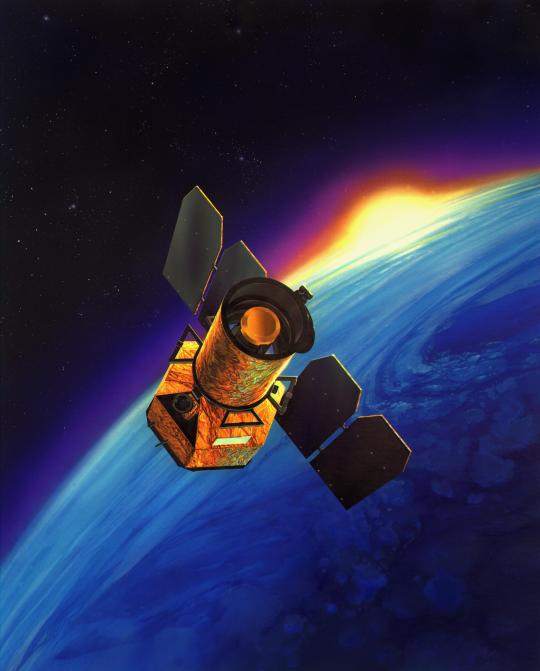
0 notes
Text

The Andromeda Galaxy~taken from NASA Galaxy Evolution Explorer
This is our neighbouring galaxy. Scientists have observed blue shift which suggests it is accelerating towards us. But not to worry, no catastrophic collision will occur and not any time soon. The spaces between stars, planets etc is so large that actual collisions are very unlikely.
#astronomy#space#astrophysics#photography#astrophotography#stars#constellations#philosophy#nasa#nebula
1K notes
·
View notes
Text
Caution: Universe Work Ahead 🚧
We only have one universe. That’s usually plenty – it’s pretty big after all! But there are some things scientists can’t do with our real universe that they can do if they build new ones using computers.
The universes they create aren’t real, but they’re important tools to help us understand the cosmos. Two teams of scientists recently created a couple of these simulations to help us learn how our Nancy Grace Roman Space Telescope sets out to unveil the universe’s distant past and give us a glimpse of possible futures.
Caution: you are now entering a cosmic construction zone (no hard hat required)!
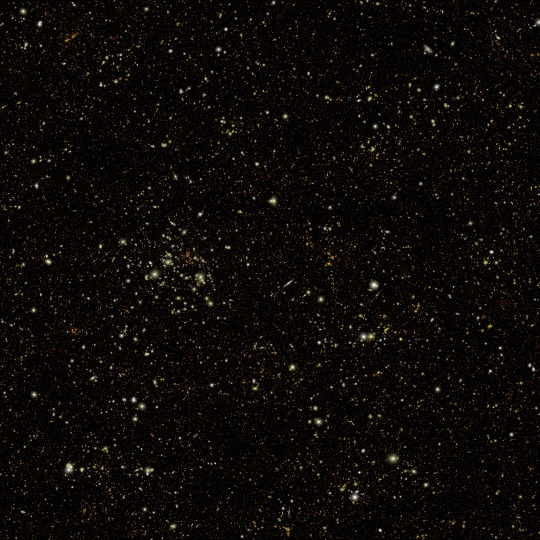
This simulated Roman deep field image, containing hundreds of thousands of galaxies, represents just 1.3 percent of the synthetic survey, which is itself just one percent of Roman's planned survey. The full simulation is available here. The galaxies are color coded – redder ones are farther away, and whiter ones are nearer. The simulation showcases Roman’s power to conduct large, deep surveys and study the universe statistically in ways that aren’t possible with current telescopes.
One Roman simulation is helping scientists plan how to study cosmic evolution by teaming up with other telescopes, like the Vera C. Rubin Observatory. It’s based on galaxy and dark matter models combined with real data from other telescopes. It envisions a big patch of the sky Roman will survey when it launches by 2027. Scientists are exploring the simulation to make observation plans so Roman will help us learn as much as possible. It’s a sneak peek at what we could figure out about how and why our universe has changed dramatically across cosmic epochs.
youtube
This video begins by showing the most distant galaxies in the simulated deep field image in red. As it zooms out, layers of nearer (yellow and white) galaxies are added to the frame. By studying different cosmic epochs, Roman will be able to trace the universe's expansion history, study how galaxies developed over time, and much more.
As part of the real future survey, Roman will study the structure and evolution of the universe, map dark matter – an invisible substance detectable only by seeing its gravitational effects on visible matter – and discern between the leading theories that attempt to explain why the expansion of the universe is speeding up. It will do it by traveling back in time…well, sort of.
Seeing into the past
Looking way out into space is kind of like using a time machine. That’s because the light emitted by distant galaxies takes longer to reach us than light from ones that are nearby. When we look at farther galaxies, we see the universe as it was when their light was emitted. That can help us see billions of years into the past. Comparing what the universe was like at different ages will help astronomers piece together the way it has transformed over time.
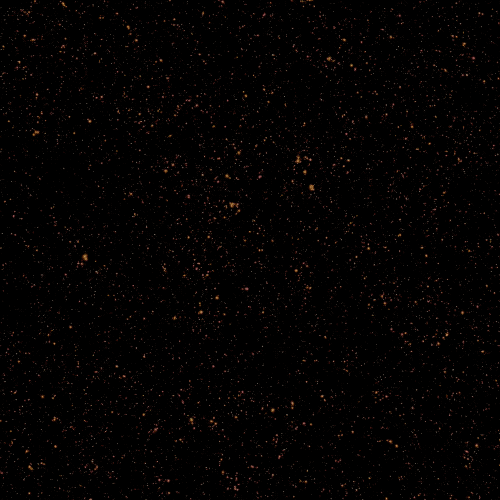
This animation shows the type of science that astronomers will be able to do with future Roman deep field observations. The gravity of intervening galaxy clusters and dark matter can lens the light from farther objects, warping their appearance as shown in the animation. By studying the distorted light, astronomers can study elusive dark matter, which can only be measured indirectly through its gravitational effects on visible matter. As a bonus, this lensing also makes it easier to see the most distant galaxies whose light they magnify.
The simulation demonstrates how Roman will see even farther back in time thanks to natural magnifying glasses in space. Huge clusters of galaxies are so massive that they warp the fabric of space-time, kind of like how a bowling ball creates a well when placed on a trampoline. When light from more distant galaxies passes close to a galaxy cluster, it follows the curved space-time and bends around the cluster. That lenses the light, producing brighter, distorted images of the farther galaxies.
Roman will be sensitive enough to use this phenomenon to see how even small masses, like clumps of dark matter, warp the appearance of distant galaxies. That will help narrow down the candidates for what dark matter could be made of.

In this simulated view of the deep cosmos, each dot represents a galaxy. The three small squares show Hubble's field of view, and each reveals a different region of the synthetic universe. Roman will be able to quickly survey an area as large as the whole zoomed-out image, which will give us a glimpse of the universe’s largest structures.
Constructing the cosmos over billions of years
A separate simulation shows what Roman might expect to see across more than 10 billion years of cosmic history. It’s based on a galaxy formation model that represents our current understanding of how the universe works. That means that Roman can put that model to the test when it delivers real observations, since astronomers can compare what they expected to see with what’s really out there.
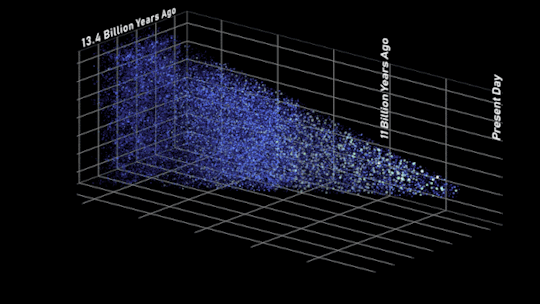
In this side view of the simulated universe, each dot represents a galaxy whose size and brightness corresponds to its mass. Slices from different epochs illustrate how Roman will be able to view the universe across cosmic history. Astronomers will use such observations to piece together how cosmic evolution led to the web-like structure we see today.
This simulation also shows how Roman will help us learn how extremely large structures in the cosmos were constructed over time. For hundreds of millions of years after the universe was born, it was filled with a sea of charged particles that was almost completely uniform. Today, billions of years later, there are galaxies and galaxy clusters glowing in clumps along invisible threads of dark matter that extend hundreds of millions of light-years. Vast “cosmic voids” are found in between all the shining strands.
Astronomers have connected some of the dots between the universe’s early days and today, but it’s been difficult to see the big picture. Roman’s broad view of space will help us quickly see the universe’s web-like structure for the first time. That’s something that would take Hubble or Webb decades to do! Scientists will also use Roman to view different slices of the universe and piece together all the snapshots in time. We’re looking forward to learning how the cosmos grew and developed to its present state and finding clues about its ultimate fate.
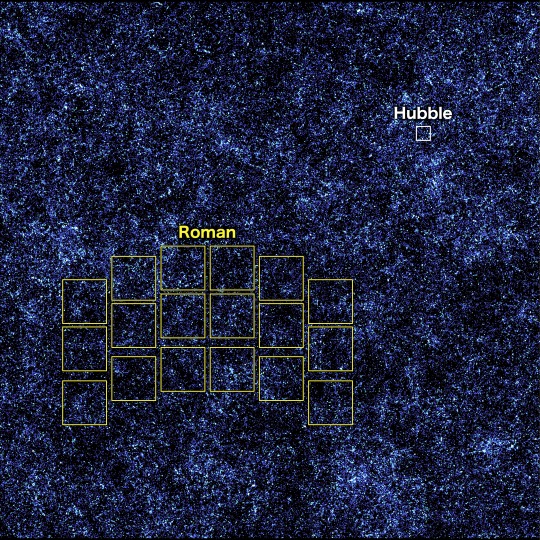
This image, containing millions of simulated galaxies strewn across space and time, shows the areas Hubble (white) and Roman (yellow) can capture in a single snapshot. It would take Hubble about 85 years to map the entire region shown in the image at the same depth, but Roman could do it in just 63 days. Roman’s larger view and fast survey speeds will unveil the evolving universe in ways that have never been possible before.
Roman will explore the cosmos as no telescope ever has before, combining a panoramic view of the universe with a vantage point in space. Each picture it sends back will let us see areas that are at least a hundred times larger than our Hubble or James Webb space telescopes can see at one time. Astronomers will study them to learn more about how galaxies were constructed, dark matter, and much more.
The simulations are much more than just pretty pictures – they’re important stepping stones that forecast what we can expect to see with Roman. We’ve never had a view like Roman’s before, so having a preview helps make sure we can make the most of this incredible mission when it launches.
Learn more about the exciting science this mission will investigate on Twitter and Facebook.
Make sure to follow us on Tumblr for your regular dose of space!
#NASA#astronomy#telescope#Roman Space Telescope#dark matter#galaxies#cosmology#astrophysics#stars#galaxy#Hubble#Webb#spaceblr
2K notes
·
View notes
Text
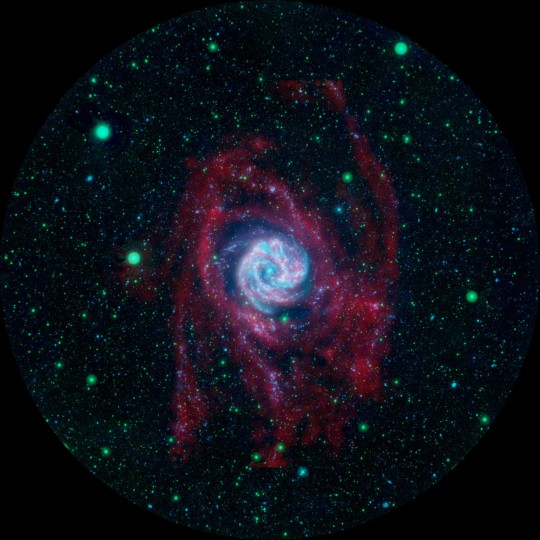
Southern Pinwheel Galaxy
"The outlying regions around the Southern Pinwheel galaxy, or M83, are highlighted in this composite image from NASA Galaxy Evolution Explorer and the National Science Foundation Very Large Array in New Mexico."
Image and information from NASA.
437 notes
·
View notes
Text
WHAT MAKES A BLACK HOLE GROW NEW STARS FROM??
Blog#382
Saturday, March 9th, 2024.
Welcome back,
When they are active, supermassive black holes play a crucial role in the way galaxies evolve. Until now, growth was thought to be triggered by the violent collision of two galaxies followed by their merger, however new research led by the University of Bath suggests galaxy mergers alone are not enough to fuel a black hole -- a reservoir of cold gas at the centre the host galaxy is needed too.
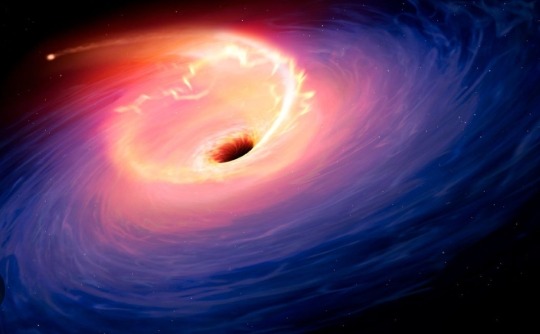
The new study, published this week in the journal Monthly Notices of the Royal Astronomical Society is believed to be the first to use machine learning to classify galaxy mergers with the specific aim of exploring the relationship between galaxy mergers, supermassive black-hole accretion and star formation. Until now, mergers were classified (often incorrectly) through human observation alone.
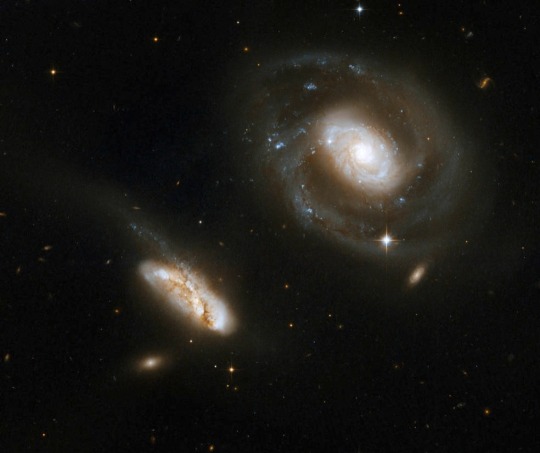
"When humans look for galaxy mergers, they don't always know what they are looking at and they use a lot of intuition to decide if a merger has happened," said Mathilda Avirett-Mackenzie, PhD student in the Department of Physics at the University of Bath and first author on the research paper. The study was a collaboration between partners from BiD4BEST (Big Data Applications for Black Hole Evolution Studies), whose Innovative Training Network provides doctorial training in the formation of supermassive black holes.

She added: "By training a machine to classify mergers, you get a much more truthful reading of what galaxies are actually doing."
Supermassive black holes are found in the centre of all massive galaxies (to give a sense of scale, the Milky Way, with around 200 billion stars, is only a medium-sized galaxy). These supersized black holes typically weigh between millions and billions of times the mass of our sun.

Through most of their lives, these black holes are quiescent, sitting quietly while matter orbits around them, and having little impact on the galaxy as a whole. But for brief phases in their lives (brief only on an astronomical scale, and most likely lasting millions to hundreds of millions of years), they use gravitation forces to draw large amounts of gas towards them (an event known as accretion), resulting in a bright disk that can outshine the entire galaxy.

It's these short phases of activity that are most important for galaxy evolution, as the massive amounts of energy released through accretion can impact how stars form in galaxies. For good reason then, establishing what causes a galaxy to move between its two states -- quiescent and star-forming -- is one of the greatest challenges in astrophysics.
"Determining the role of supermassive black holes in galaxy evolution is crucial in our studies of the universe," said Ms Avirett-Mackenzie.
Originally published www.sciencedaily.com
COMING UP!!
(Wednesday, March 13th, 2024)
"WHAT IS BEYOND THE EDGE OF THE SOLAR SYSTEM??"
#astronomy#outer space#alternate universe#astrophysics#universe#spacecraft#white universe#space#parallel universe#astrophotography
83 notes
·
View notes
Text
Something I've never really understood is people comparing Star Trek and Star Wars. Not only because the genres are so different (sci-fi vs sci-fantasy) or the fundamental difference that is the absence of Earth entirely in the Star Wars universe (Star Trek is meant to be about a recognisable, if improbable, future, whereas Star Wars is a Space Opera a Long Time Ago and Far Far Away).
But the biggest difference I see is that the two are set in fundamentally different times.
Yes, yes, I know that's obvious. I literally just pointed out the 'Long Time Ago' bit, but bear with me.
Star Trek is set in a time where exploration is still the order of the day. The Alpha quadrant is still being explored, new species are still being discovered. The Beta and Gamma quadrants are the big new frontiers. The Delta Quadrant has one very hazily mapped squiggly line with a few gaps thanks to Voyager but even that small portion was chock full of New Things. The Galaxy is still divided and unknown with new stations and trade routes popping up all over the place.
Meanwhile Star Wars is old. Real old. By the time of the Clone Wars the Republic has gone through different eras. There was a golden age. It has come and gone already. Sure there are still the Unknown Regions but it is fairly fucking rare to come across a brand spanking new space-faring race or rival government. Coruscant as the heart of the Republic has not been outright attacked for a millennium by the time of the CW. The galaxy is such a hot mess of a melting pot that only the truly reserved and isolationist species are rare to see. Humans have been buggering about and propogating so much that now its impossible to tell where they actually all came from because Alderaan? Naboo? Corellia? All major human hubs, but you could say the same about dozens of other planets, and as far as anyone can tell, at least some of the near-human species are almost definitely genetically related to humans so there has clearly been enough time for some natural evolution after the space travel.
I just find it so interesting that people try to compare them when they are at fundamentally different stages of galactic development. Its like comparing the Wild West to the modern day. The galactic governmental structures and attitudes are so amazingly different and that is to the franchises' strengths.
Star Trek is about, at its most basic point, exploration.
Star Wars is about, again at its most basic, adventure.
Sounds similar? They are similar, but whereas in Star Trek the New Things are new, in Star Wars they're new to those characters, or at least new to the audience.
Kirk and Spock are exploring the unexplored.
Luke and Han and Leia are having adventures in an already clearly established society. They forging new paths in an already defined environment.
They're both also, coincidentally, fighting evil Space Fascists but that's just par for the course. I think something about space just Does That. The Void inspires assholes to go 'I can conquer those stars!' only for said stars to pull an uno reverse in the shape of a blond kid with little to no self-preservation skills but a knack for flying spaceships.
Something something space something something sci-fi.
TL:DR Star Wars and Star Trek are different on so many levels but the most interesting one is the fact they're represent galactic civilisation but at different stages. The 'fun, exploration, everything-is-new!' stage, and the 'established society including rampant corruption, unfortunately' stage.
I love 'em both.
#star wars#star trek#meta#galactic civilisations have stages#Star Wars went through its own Star Trek period with the Hyperspace Wars#Wish we could get more material on that time period tbh#A time when “Punch it Chewie!” could have sent them careening into a fucking star because nobody mapped that bit of space yet#Plus the Jedi as an institution has been pottering about for 25000 years#Though I suppose it would be more accurate to say the Je'daii Order did#The Jedi as they became technically started a bit later after that whole Schism thing#I know an unhealthy amount of Star Wars history#To be fair#Its very interesting
149 notes
·
View notes
Text
Also, Morph.
I was too busy letting child/teenage Steffie freak out about the delicious Romy relationship drama and that it’s setup from jump as being a large story focus, and how amazingly they handled keeping the feel and tone of the show (I love that the animation is true to the original, they could have modernized it, but they kept that choppier feel - it’s perfection. Gah I can’t. Morph. This post is about Morph.)
Morph is genius. Adding them to the show in this capacity is such a brilliant galaxy brained move. Like, not only does Wolverine get his bestie back, Morph also gives us little flashes of other beloved characters that probably won’t be making an appearance. And I love that this show about bigotry and othering can finally explore the NB aspect of their character. They are also hilarious. The Jean and Scott joke had me cackling.
And the show is using their ability BRILLIANTLY. I already loved the evolution of how everyone was using their powers (Cyclops using his concussive ray for movement in the warehouse made me yell.) because it showed natural progression, team dynamics, so many amazing combos. So many adaptations, including the OG X-Men cartoon don’t take any creative license with the powers or use them in new and interesting ways and X-Men 97 was like “Nah, bitch, we getting wild with this”. And Morph is going to BE SO GOOD AT IT.
My only issue. MY ONLY ISSUE, is Morph keeps tricking me. I keep forgetting Morph being around is a thing now so when Lady Deathstrike (Yuriko, my beloved, the movies did you so dirty) popped up I was like WHAT and then me and my partner were like “FUCK, MORPH”.
It happened like twice 🤣 and it will def continue to happen.
I just have a lot of feelings. So many feelings.
66 notes
·
View notes
Text
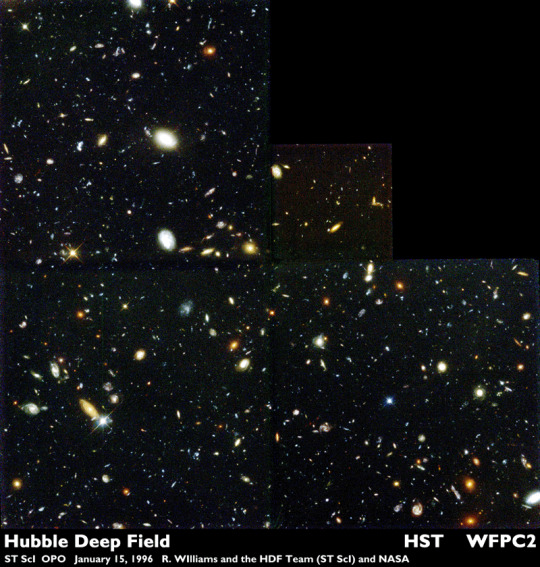
The Deep Field - January 24th, 1996.
"The image above is part of the Hubble Deep Field and represents humanity's most distant yet optical view of the Universe. Galaxies like colourful pieces of candy fill the field, some as faint as 30th magnitude (about four billion times fainter than stars visible to the unaided eye). The dimmest objects are the most distant galaxies and reveal what the Universe looked like in the extremely distant past, perhaps less than one billion years after the Big Bang. To make the Deep Field image, astronomers selected an uncluttered area of the sky in the constellation Ursa Major (the Big Dipper) and pointed the Hubble Space Telescope at a single spot for 10 days, accumulating and combining many separate exposures. With each additional exposure, fainter objects were revealed. The final result can be used to explore the mysteries of galaxy evolution and the infant Universe."
137 notes
·
View notes
Text

Solstice
Solar System Stargate. Dec21-22.
Talon Abraxas
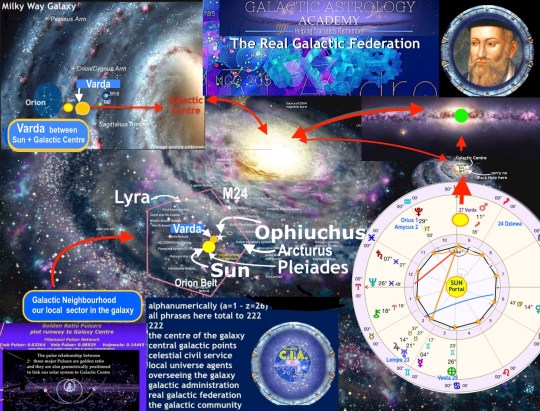
Between us here in our solar system and Milky Way centre lies the Sagittarius Cloud, a group of stars including the cluster M24, the Urantia Book locates M24 in their cosmology as the HQ of our pizza slice of the galaxy where Seraphim Angels aid the transfer of Souls to star systems.
Pre-Founder Galactic Centre StarSeeding energetic templates from Central Sun, came to fruition in Lyra.
.
Galactic Centre Administration - Inhabits the centre of a galaxy and are those Elders termed Masters and Celestial Beings. These Elders travel between galaxies and help where necessary and have the capability to influence and direct Source plan for continued evolution.
ET groups like the Galactic Federation (real one), Guardian Alliances etc come under their wing.
.
Wingmakers claim that by tuning into our GC we 'enter the galactic centre tributary zone', thereby gaining access to what they termed 'encoded sensory data streams', inspiring new forms of creativity, in the arts, sciences, social sciences, and more.
While the Galactic Feds and Guardian Alliance groups focus more on a 'rescue mission'.
.
Numerous groups of out-of-body explorers have transported themselves to our GC, including the Monroe Institute, their 'STARLINES program' focuses on establishing and strengthening the link between Earth and the Galactic Core.
.
Back in the 1500s our earth aligned the GC on Dec 14th, Nostradamus's birthdate.
144 years ago the alignment was on the 16th, Alice Bailey's birthdate
Around 2222 the alignment from our Earth thru our Sun to GC will take place exactly at the Solstice.
.
We've been providing evidence, for decades, that the, local to earth Solstice, takes place at the point where the solar ecliptic intersects the galactic equator *at the all-important Stargate Portal angle of 60deg, the conic angle of a golden ratio spiral.
--Grayham Forscutt
66 notes
·
View notes
Note
goh starter trio meta perhaps? i was ensnared by the goh-scorbunny parallel subpoint in the cubone meta bc i'm making myself unwell thinking about how scorbunny latching on to goh and goh latching on to ash.... but also more generally, sobble's whole thing and the absolute tearjerker drizzile evolution episode, and goh's weird ass dream about his rillaboom parents and then waking up to baby grookey clinging to his arm, you get it, i know you're galaxy brained about this
YESSS I AM *SO* GLAD YOU ASKED!!
so my tl;dr here is that all of the galar starters represent something about goh specifically relating to his childhood. their growth and eventual evolution (or lack thereof!) therefore serve to highlight his character development (as an aside, i think this is a very common theme in anipoke. ash's pikachu not evolving speaks to the fact that ash's growth isn't about becoming someone new but about staying true to himself and embracing a battle style that reflects the creative ingenuity that, in the early os, other characters mocked him for. similarly, dawn's piplup chooses not to evolve because it doesn't want to change how things are between them. does this not seem fitting for the partner of someone like dawn, who has always admired her mother so much that she never even considering doing something other than following in her footsteps? i'm sure there are other examples, but these seem to me the most obvious ones!).
let's break down each one, then!
scorbunny
when we meet scorbunny, goh is still determined that mew will be his first pokemon. this is a point of stubbornness that, while impressive and arguably kind of admirable, is frankly kind of stupid. how is he supposed to get to mew without any pokemon to help him? there's an interesting implication in this resolution, which jn004 and jn005 really highlight for us - goh isn't comfortable with having a pokemon. he knows a lot about them, is interested in researching them, but as far as the bond between pokemon and trainer goes, i don't think he feels prepared for that. it's easier to pick a target that is far from reasonably attainable for him at this point, especially since he does have some history with mew - didn't it take an interest in him? didn't it give him a reason to chase after it?
so meeting scorbunny, he's obviously not thinking about catching it. but he lies to the guy at the scone stand, in an interesting parallel to how scorbunny steps in to protect the nickit. he doesn't even seem to know why he does it. but just before that scene, he sees scorbunny wipe some of the dirt off its face. he doesn't get the whole story and connect all the dots until after, but i think he realizes then that scorbunny is trying to hide itself in some way. that it's performing as something it's not. and on some unconscious level, that motivates him to lie for it. after, we get this whole exchange, where the scone seller tells ash and goh the story

and this note is what makes goh get up and approach scorbunny and the nickit:



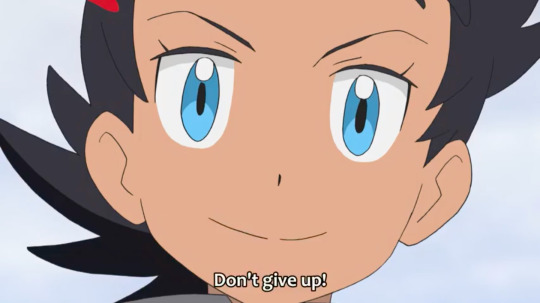
it's very symbolic that he wipes the mud off scorbunny's face. and then later, he even points out when they see it again that it looks better without all the mud covering it up - it looks more like itself. it's not pretending to be something it's not. goh wiping the mud off its face is him saying that he accepts it as it is. that being resigned to living a certain way just to fit in or just because that's how it's always been is pointless.
and i mean...even ash says in this scene that the things goh is saying are things he's only recently learned himself, right? goh denies it (and tbh when he says that he's always thought the world is big and anyone can explore it if they want to or whatever - i don't think that's untrue! i think it's just that, prior to meeting ash, he didn't have it in him to explore it), but ash has a point. and what goh is doing for scorbunny here is the same thing that ash did for him.
relatedly, scorbunny follows him, right? in the same way that goh "accepts" ash as his friend, scorbunny chooses goh as its trainer. goh recognizes that it travelled far for him, that it saw a vision of its future with him, and changes his mind about not catching it. i think the determination he saw in scorbunny to chase after its dreams resounded with him, because he's only just started doing the same thing. and his entire character is built around this idea of like, learning how to adapt and how to let other people help you find the courage to chase your dreams (and even to help you chase them). how could he possibly deny scorbunny the same thing?
but while scorbunny's enthusiasm helps motivate goh to chase his dreams, he is very flippant and dismissive, as we see when it learns ember and he says it doesn't matter, that scorbunny doesn't need to know a fire-type move and this gut-punch of a line, of course:

goh is someone who needs a lot of convincing to do things he doesn't think he'll be good at (or enjoy). he only joins project mew because gary goads him into it. he spends most of his life refusing to make friends, because he had one bad experience. he's a fairly black-and-white thinker, which makes sense considering his background. he doesn't really believe in change. he especially doesn't believe that people (or pokemon, in this case) can change their circumstances just through hard work and determination. as we see in jn003 with the ivysaur, he also doesn't think that it's anyone else's place to intervene and "help" others. if you can't change something, then don't. and there's no point in hoping it'll change on its own, either.
when scorbunny storms off here, his expression is interesting. this isn't the expression of someone being judgemental. it's the expression of someone who sympathizes.
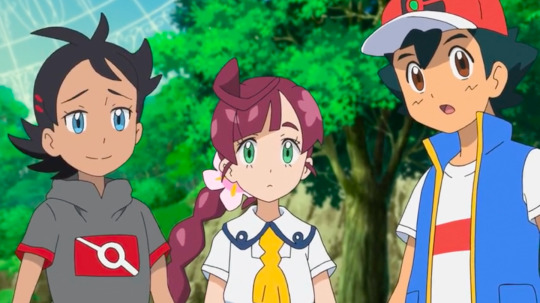
he sees scorbunny trying so hard to do something he thinks it can't do and thinks that scorbunny's determination to change things is, if i had to guess, kind of immature. a lesson scorbunny will have to learn, whether it wants to or not. at first it's kind of endearing, but then he actually gets frustrated, because he feels like scorbunny's determination to learn ember is harmful to them both. here, there's a degree of "why won't you just trust that i know what's best for you?" for sure, but on a deeper level, i think that stems from a place of "can't you see that i'm just trying to protect you?"
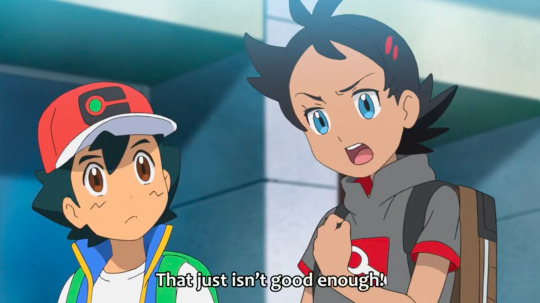
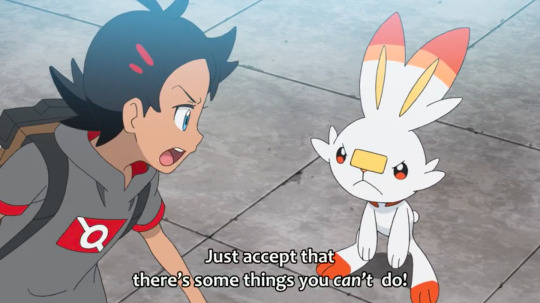
...but obviously, all he really does is wind up lashing out and hurting scorbunny's feelings. he tells ash that he was trying to draw out scorbunny's strengths (and he was, by telling it to use moves it was already good at!), but ash points out that their values weren't aligned and that's kind of the opposite of strength when it comes to pokemon battling. so he reassesses the situation and finds a way to bring out scorbunny's strength that also aligns with what scorbunny wants. that compromise is what makes scorbunny evolve. it was the right call! but then raboot starts ignoring him.
and this is like. a running gag with scorbunny - goh gets distracted by other things and doesn't notice that it's trying to show him things. it happens when they meet and it happens again in this episode with its ember. we see something very similar with goh and his parents in jn032 when he's excited at the prospect of their vacation together, but when he tries to ask what they want to do, he turns around and find they're both asleep (and we see the flashback of something similar happening last time, too).
with raboot, in a lot of ways, goh is grappling with...himself. or at least, the person he was before he met ash - cold and distant, more interested in doing whatever he thinks is worth his time than in school, for example. so if goh saw his child self in scorbunny, he sees his more "adolescent" (i mean. he's still ten so still child, technically. but older child lol) self in raboot. and he actually responds to this in a way that's a lot like how we see his parents responding to him. in jn022, we see him
buy a bunch of apples for raboot, even though he thinks it doesn't need them (and is hurt when it doesn't let him have one, despite raboot seeming pleased that he bought them for it). compare to the device he shows horace in jn032, for example, which he says his parents built for him. or his six computer monitors. his parents reach him best through material means!
question why raboot hates him when it's not responsive to his overtures. contrarily, goh's parents don't think he hates them; they just automatically assume the worst case scenario (like in jn015 when he calls and they immediately wonder if he did something and got kicked out of the institute). but while that's their worst case scenario about him, raboot hating him is kind of goh's worst case scenario, right? it took him time to open up and accept scorbunny as his partner. now that it's evolved and is acting differently, he's terrified that he came to care for it only for it to leave him.
which leads to my last point here, which is that he doesn't actually ask what it wants. in this episode, he concludes that raboot would be happier without him. so he leaves it behind, but he never actually considers how it might feel. goh's parents do the same thing! they worry about him, but they don't share their concerns or ask how he feels. they just assume that he must feel a certain way and they adapt to compensate for that. but they never actually ask him what he wants.
this episode ends with him realizing that he hasn't been reacting to raboot's feelings so much as to his own, of course, and we see their relationship smooth out quite a bit. he's acknowledging that he's done things wrong, but also that it's not all his fault - and raboot's change in temperment is just a consequence of it evolving. they accept each other again and move on.
then, it evolves into cinderace and kind of opens up again more (though it's been doing that little-by-little since jn022). i think the fact that raboot and riolu evolve at the same time was a really cool move by the writers to kind of demonstrate how like...the relationship between ash and goh is reflected in the growth of their pokemon. they trained together! in a way they kind of grew up together! riolu, ash's token baby pokemon in jn, evolving at the same time as goh's starter feels like a very deliberate choice to highlight how ash helped goh's pokemon grow, too - through getting the ball rolling with how he helped goh grow as a person and a trainer. if that makes sense?
anyway, i don't have much to say about cinderace, other than that if he saw himself as a child in scorbunny and as an older child in raboot, then cinderace's level of openness and its enthusiasm aren't just reflexive of it getting back more of its scorbunny-esque personality - it also shows how goh has changed and has learned to embrace these parts of himself, now that he's in that "coming of age" age (well, for pokemon. he is still only ten lmao).
i think we see something similar with his other starters, though maybe a little less on the nose.
sobble
the drizzile episode, as you mentioned, is probably Thing here. but i think the theme with sobble is sort of that, where scorbunny maybe reflects more of the way goh thought about growing up and his aspirations (and how hard it was to open up to people), sobble more so mirrors his social experiences at school and with chloe.
VISUALLY, i think it's really telling that when goh catches sobble, he's...literally speaking to it from the other side of the water:


this whole episode (jn028) is about goh kind of...forcing sobble into positions it's not necessarily comfortable with, and not realizing that it's uncomfortable until it runs away from him. as we saw with raboot, this is a common theme with goh - but it's most obvious with sobble!
he realizes, of course, and says this:


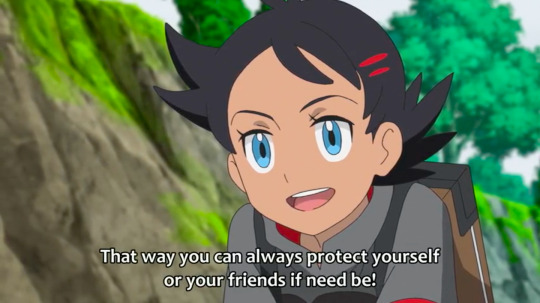
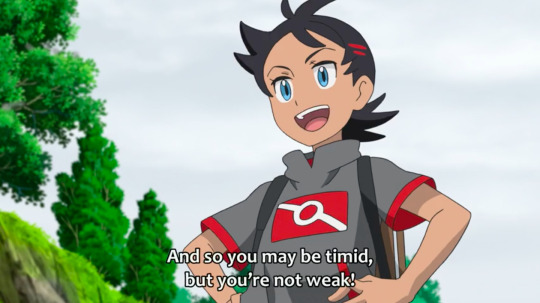
even in flashbacks, goh never comes across as a shy kid. he doesn't exactly relate to sobble, but i think he's drawing a parallel here between them. he wasn't shy, but he was always on the "outside" - that's why he's so good at researching. he strives to see things as they are without getting involved. eventually, this is something that will make him a pretty thoughtful and strategic battler, though at this point he's still learning how to apply that to more than just research for the sake of research.
and then after sobble meets inteleon, we have these bits too:

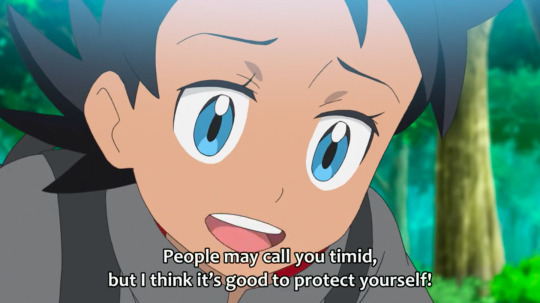
goh's childhood motivations on the surface appear to be like...he doesn't want to bother with friends, because they aren't going to be able to serve a purpose for him. he isn't interested in making friends with anyone who is less into pokemon than he is. but after what happens with horace, it seems to get a little more complex, and then we have to wonder if his motivations really were that surface-level to begin with, or if, maybe, his policy of not making friends has always been a way for him to protect himself from betrayals like he experienced with horace.
we see chloe as early as jn001 trying to convince him to make friends, to no success. she doesn't even refer to herself as his friend - he doesn't seem to be willing to let her. he believes he doesn't need friends and is better off alone. but he doesn't realize until after meeting ash that his solitude is more of a self-imposed exile, in that it's hurting him more than other people. he can't improve as a person and reach his goals if he's too busy trying to protect himself to accept that he needs help from other people to do those things. so, again - i think he sees that side of himself in sobble. so it feels very impactful that he reaches out to help sobble become a better battler, but rather than forcing it to battle in a way that makes sense to him, he comes up with a way to have it train that plays off of its strengths of running and hiding.
and then, of course, there's the episode where sobble evolves, jn062. the writers themselves do most of the work here of drawing the parallel between goh's childhood and how drizzile is feeling, but i think it goes even deeper than that. drizzile is unhappy because it wanted to evolve into inteleon, not into drizzile. it's not comfortable in its own skin. and it doesn't necessarily want others to see it, because it feels like it's still growing and it's not ready yet. it kind of just...needs time to sulk and brood. drizzile runs away again, because it's not ready, and while they're looking for it, it's chloe who makes goh start thinking about when he was a kid, by saying this:

which prompts him to think about how he was searching for a "reason" for why drizzile was acting how it was, just like how adults used to demand reasons from him even when he didn't have them. and then of course we get this scene:



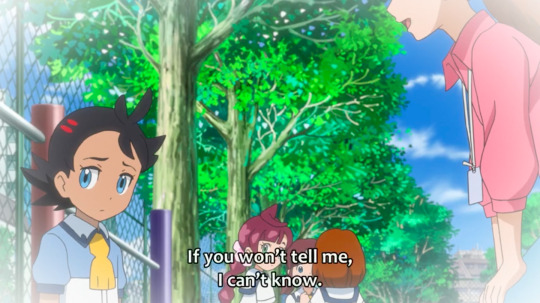


but i think he does on some level know why, because he talks immediately after this about how his parents weren't home and often felt lonely. he's more comfortable being alone. he's protecting himself. which is reinforced by the fact that he then tells drizzile this:


goh has a hard time putting his feelings into words, which is something we see throughout jn. he sees that drizzile is the same and this is a huge moment for him, because he's saying here that it doesn't matter what inspired its feelings; he understands it is experiencing those feelings and that's enough. he'll wait until it's ready to fully process them or whatever else it needs. drizzile kind of returns the favour when he starts crying here and it reaches up to brush away his tears, then disappears again.
overall, this episode does an amazing job of showing us how goh has become someone who actually acknowledges his and his pokemon's feelings - this is the only time we see him as a child where he's not doing something to try to ignore his feelings, or trying to walk away from them. in flashbacks, his back is often to his parents. in jn032, he gets upset, and then tries to cover his disappointment up immediately with anger and avoidance. the writers set this scene up so that we can see the reason behind his feelings clearly (just like we can see the reason behind drizzile's, even though goh and co. can't), but they rightly emphasize that goh's ability to analyze "why" he or his pokemon are feeling a certain way isn't always helpful. emotions are meant to be felt, not intellectualized. it's a good message, and a huge area of growth!
drizzile's evolution into inteleon also shows us how this acceptance translates into it eventually being comfortable enough to be who it wants to be. and the characters are impressed by it - it even earns kecleon's admiration, the same way that other inteleon earned its when it was a sobble. this is a pretty clear mirror with goh's social life, where he went from being this friendless outcast figure to someone with a lot of friends, and a great willingness to make more, as he became more comfortable and confident and willing to reach out to others.
and lastly,
grookey
the only one of the three that doesn't evolve, for reasons that aren't ever really made clear to us. but i think that as random (...and tone deaf) as his dream sequence at the start of grookey's debut episode is, it actually makes a lot of sense. in the original, the dream has camille and walker transformed into rillaboom, and goh is understandably freaked out. but i think the bigger, more symbolic thing is that even if it is a dream, his parents are the ones that foist grookey upon him. this does seem like a really weird choice, until you start thinking about the parallels, right?
in reality, grookey is team rocket's pokemon. the episode title "when a house is not a home" tells us that grookey obviously doesn't feel like it "belongs" there. but the episode doesn't open in team rocket's base. it opens in goh's apartment. and the part i didn't show in the drizzile scene above is when he says this:

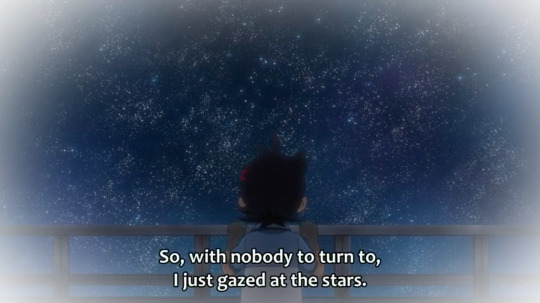
the fact that goh was home alone a lot as a kid gets brought up fairly often. it implies that he kind of had to adopt this lone wolf persona, because there was no one else around to take care of him. he had to learn how to console himself and meet his own needs (hence why he's so combative about ash intervening with the ivysaur in jn003!), which is a lot of responsibility for a kid. grookey is handed to him like it's a responsibility in his dream, but then they bond. and he starts to appreciate having grookey around, to the point that he misses it when it returns to team rocket.
to me, the choice to have grookey not evolve kind of comes down to grookey being kind of...emblematic of goh's childhood. like, in his dream, grookey is this burden that's forced on him. someone he has to take care of, even though he isn't really prepared to do that. in reality, grookey is escaping from an environment that doesn't meet its needs. putting those two things together, i mean...that's just my reading of it, anyway. so grookey not evolving, and goh accepting grookey as it is - without any of the "growing up" analogs we have with cinderace and inteleon - is a way of showing that goh has come to terms with his childhood and that he accepts (and cherishes!) his childhood self. which he can only really do after he's done all the growing we see reflected in the evolutions of his other starter mons. (relatedly, grookey is the only starter of goh's who goh considers leaving with other mons in its evolution line. specifically, with two thwackey and their child, i.e. a family unit not unlike goh's!)
anyway! this is a very long post, so thanks for sticking with me if you did. hope my takes are as galaxy-brained as you hoped hehe
#answered#*meta#pokemon#anipoke#goh#meta#phew sorry this took so long. it was all in my brain i just had to get it out there lmao#i think i also almost hit the image cap on this post so dhjfghjfdk#anyway i will die on this grookey hill 100%. i am SO glad they never evolved it :p
30 notes
·
View notes
Text
Galaxy Evolution Explorer Searches for Light
This Dec. 21, 2002, artist’s concept of NASA’s Galaxy Evolution Explorer imagines what the space telescope would look like during its mission. Launched April 28, 2003, it studied the shape, brightness, size and distance of galaxies across 10 billion years of cosmic history. By observing ultraviolet wavelengths, the telescope measured the history of star formation […]
from NASA https://ift.tt/yGDixOK
0 notes
Text
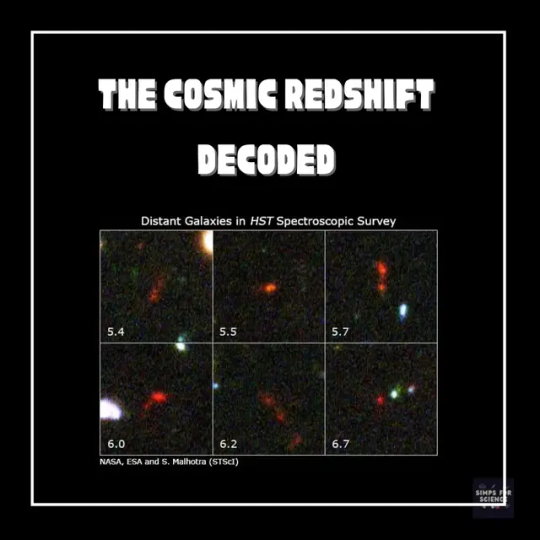
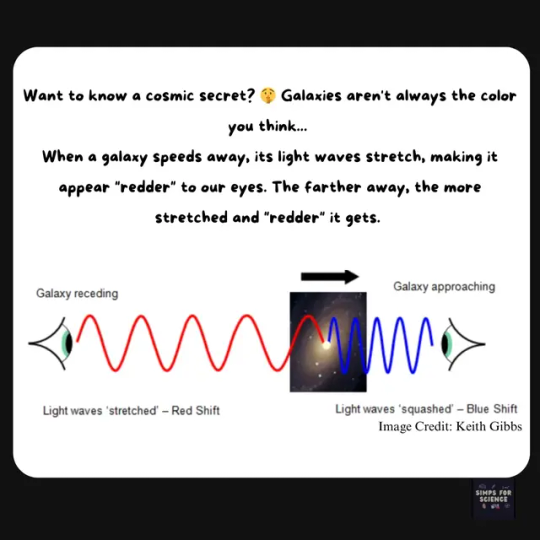
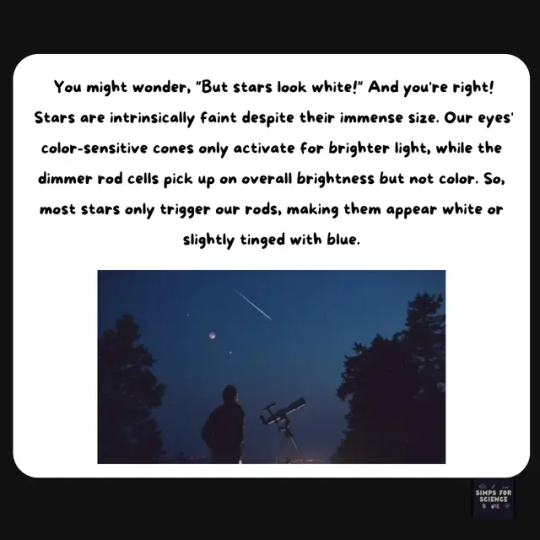

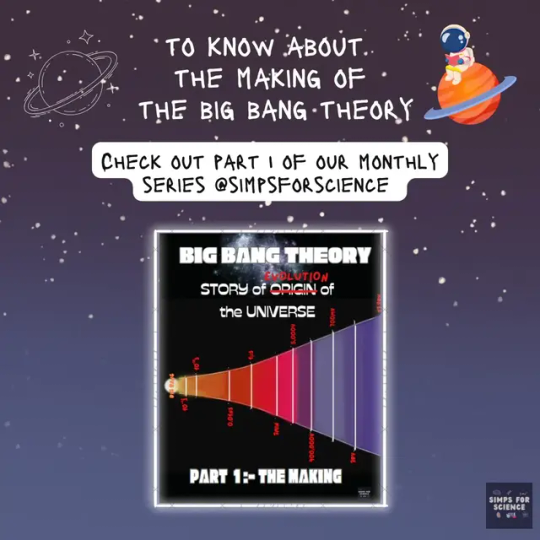
What if you're told that the stars that appear to be white aren't always white ⬜?Ever wondered why do galaxies wear the cloak of redshift? 🤔Swipe ➡️ through to unlock 🔓 this mystery. To explore more about the cosmic evolution, follow our monthly series - Big Bang Theory ✨.
#education#science#science facts#study blog#research scientist#discover#scicomm#earth#explore#universe#expanding universe#cosmology#cosmos#space#nasa#astrophysics#astronomy#physics#physicist#redshift#hubble#albert einstein#knowledge#comics#big bang#galaxy
39 notes
·
View notes
Text
Unveiling the Mysteries of Black Holes
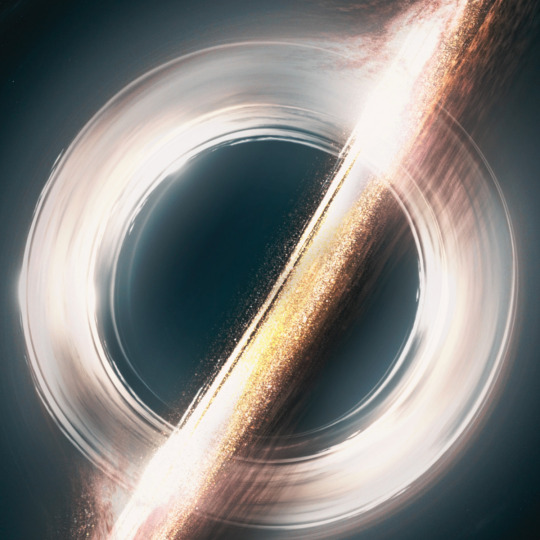
Black holes, enigmatic cosmic phenomena predicted by Einstein's theory of general relativity, have captivated scientists and the public alike for decades. These mysterious entities, formed from the remnants of massive stars, possess gravity so strong that even light cannot escape their grasp. Exploring black holes has reshaped our understanding of space, time, and the fundamental laws of physics.
Birth of a Black Hole: Stellar Collapse Black holes originate from the explosive aftermath of massive star deaths. When a star exhausts its nuclear fuel, gravity overpowers the outward pressure, causing the star's core to collapse. If the core's mass exceeds a critical threshold, known as the Chandrasekhar limit, it collapses into a singularity, an infinitely dense point, surrounded by an event horizon – the boundary beyond which nothing can escape.
The Gravity Abyss: Warping Space and Time Einstein's theory of general relativity describes gravity as the curvature of spacetime caused by massive objects. Black holes embody this concept to the extreme, warping space and time so severely that they create a gravity well from which nothing, not even light, can emerge. This phenomenon challenges our classical understanding of gravity and beckons us to explore its most extreme consequences.
Revealing the Unseen: Detecting Black Holes Detecting black holes poses a unique challenge due to their invisible nature. Scientists rely on indirect methods. X-ray emissions from matter spiraling into black holes can betray their presence, as can gravitational effects on nearby stars. The LIGO and Virgo observatories have pioneered gravitational wave detection, allowing us to sense the ripples in spacetime generated by black hole mergers.
Size Matters: Stellar and Supermassive Black Holes Black holes vary in size. Stellar-mass black holes, formed from individual star collapses, typically range from a few to several tens of solar masses. In contrast, supermassive black holes inhabit galactic centers and can weigh millions or even billions of times our sun's mass. The processes behind these size differences remain active areas of research.
Dance of Destruction: Black Hole Accretion Disks As black holes pull surrounding matter into their grasp, they create accretion disks – swirling discs of gas and dust. Friction and heat generated within these disks cause them to emit powerful X-rays and other forms of radiation. Studying these emissions provides insights into black hole properties and behavior.
Event Horizon Telescope: Peering into the Abyss In April 2019, the Event Horizon Telescope made history by capturing the first-ever image of the event horizon of a supermassive black hole at the center of galaxy M87. This feat involved coordinating multiple radio telescopes globally, simulating a telescope the size of Earth. The image not only confirmed the existence of black holes but also provided visual evidence of their mind-bending nature.
Hawking Radiation: Black Holes Aren't So Black Black holes aren't completely dark. According to physicist Stephen Hawking, black holes can emit radiation due to quantum effects near the event horizon. This phenomenon, known as Hawking radiation, challenges our perception of black holes as purely consuming entities. It implies that they can slowly lose mass and evaporate over time.
Black Hole Information Paradox: Cosmic Conundrum The nature of information within black holes is a conundrum known as the "black hole information paradox." According to quantum mechanics, information cannot be destroyed, yet black holes seem to violate this principle by absorbing everything that falls within their grasp. Resolving this paradox is a frontier in theoretical physics.
Black Holes and the Cosmos: Galactic Evolution and Beyond Black holes play an integral role in galactic evolution. Supermassive black holes influence their host galaxies through processes like quasars, which emit immense energy. Black hole interactions and mergers also contribute to the universe's dynamism. Understanding these roles enhances our grasp of cosmic evolution.
Beyond the Horizon: Ongoing Exploration The exploration of black holes is an ongoing endeavor, intertwining multiple disciplines, from astrophysics to quantum mechanics. As technology advances, we inch closer to unlocking the secrets of these cosmic enigmas. With initiatives like the upcoming LISA mission to detect gravitational waves from space, our understanding of black holes is poised to expand further, offering glimpses into the deepest corners of the cosmos.
In conclusion, black holes stand as some of the most enigmatic and awe-inspiring entities in the universe. Their influence stretches across space and time, defying our conventional understanding of reality. From their mysterious birth to the intricate dance of matter around them, black holes continue to challenge our intellect and inspire us to unravel the mysteries that lie within their gravitational grasp.
88 notes
·
View notes